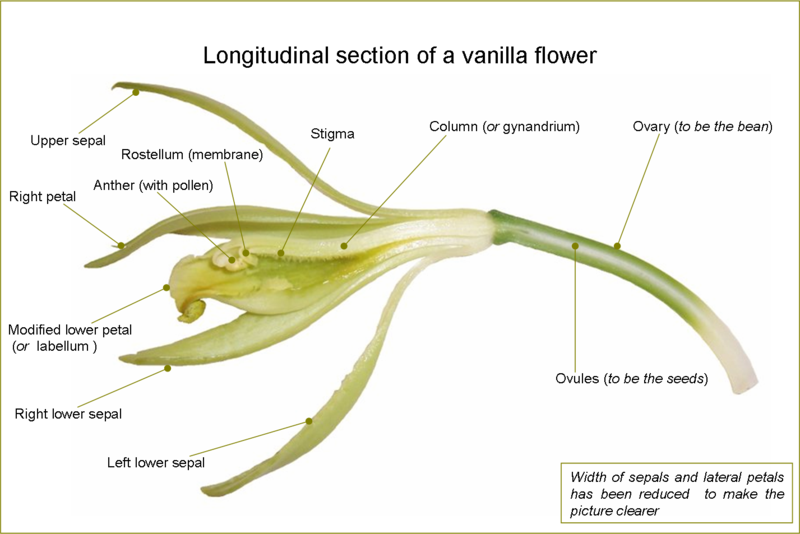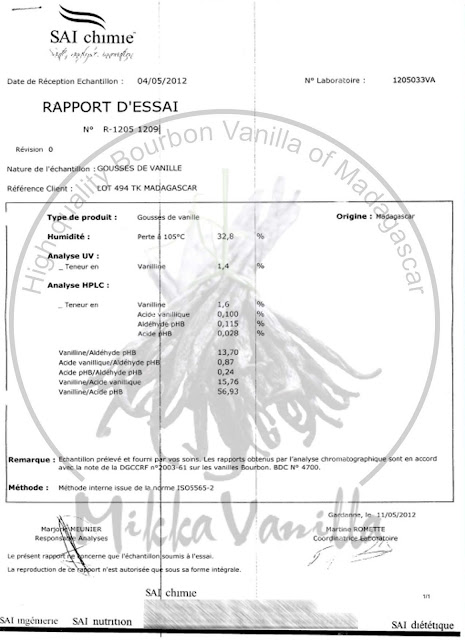 There are many species of vanilla thriving around the world; about 110 species have been catalogued since the discovery of vanilla. The plant that produces the vanilla bean/pod is an orchid. The family to which the species belongs is Orchidaceae, one of the largest families of flowering plants in the world. There are 700 genera in the family Orchidaceae and approximately 20,000 species.
There are many species of vanilla thriving around the world; about 110 species have been catalogued since the discovery of vanilla. The plant that produces the vanilla bean/pod is an orchid. The family to which the species belongs is Orchidaceae, one of the largest families of flowering plants in the world. There are 700 genera in the family Orchidaceae and approximately 20,000 species.Orchids are best known for their beautiful flowers, which are economically valuable to the horticultural industry. However, vanilla beans is the only genus that has economic importance as a food source.
Vanilla beans is a fleshy, herbaceous vine that is perennial and climbing. It grows to a height of 10 to 15 metres, supporting itself on the host plant with aerial roots. Roots are produced all along the stem, opposite to leaves. Under cultivation conditions, vanilla is trained and pruned to a height that will allow hand pollination of the flowers and subsequent harvest of the beans.
The stem is cylindrical in shape and monopodial in growth pattern, with means the central stem produces secondary branches that always remain subsidiary to the main stem. Leaves are flat and fleshy and have a short stem. They are bright green and vary between elliptical and lanceolate in shape, with an acute, rounded tip.
Arranged along the stem in an alternate pattern, vanilla leaves vary a great deal in length and width; between eight and 25cm in length and two and eight centimetres in width. In the forest it grows from the floor into the treetops –leaves are larger and healthier, the more sunlight they receive.
Vanilla flowers are fragrant, waxy and large. They are pale green- yellow in colour with a short broad labellum and the upper petals are slightly smaller than the sepals. Flowers are held on long, thick rachis in groups of 20-30. Each inflorescence measures approximately eight centimetres and usually displays three or four open flowers at a time. If flowers remain un-pollinated, they last only a day.
The fruit is a capsule, but in the trade of vanilla it is referred to as a “bean” or “pod”. On the plant, before harvesting, the bean is pendulous, and cylindrical but three-angled in shape. It reaches 10-25cm in length and about 1.5cm in diameter, at harvest size. After the beans are harvested and cured they develop their aromatic fragrance.
In Mexico and Central America bees and hummingbirds pollinate Vanilla flowers, but self-pollination is impossible in other parts of the tropical world. Due to the structure and position of the stamen and the stigma and a lack of natural pollinators, hand pollination is necessary in most places where vanilla is farmed.
The most effect method used, to hand pollinate vanilla flowers was discovered in 1841 and is still in use today. Individual flowers are pollinated in the early morning, directly after opening. A small stick of bamboo about the size of a toothpick is used to pollinate. The rostellum is pushed aside and pollen is spread from stamen to stigma by causing contact between the two.
 Vanilla flowers once a year over a period of about two months. Flowers open from the base of the raceme upward, with only two or three flowers open at once. Commonly, flowers open in the early morning and remain receptive to pollination for eight hours. If fertilization has been successful, the flowers remain on the rachis for two or three days. If fertilization has not occurred, the flowers will wither and die after one day.
Vanilla flowers once a year over a period of about two months. Flowers open from the base of the raceme upward, with only two or three flowers open at once. Commonly, flowers open in the early morning and remain receptive to pollination for eight hours. If fertilization has been successful, the flowers remain on the rachis for two or three days. If fertilization has not occurred, the flowers will wither and die after one day.From the state of the flowers, cultivators can judge the number of fruits that have set and control the number of beans to a plant.
In the wild as a native plant, all vanilla species grow by climbing on trees in wet tropical jungles from sea level to about 600m. Vanilla thrives in a humid, hot climate with consistent rainfall. The best average temperature for vanilla production is 28 degrees Celsius, but it will tolerate a range between 21C and 30 C. Average rainfall required is about 2000mm (80 in) spread over ten months, with two months of dry weather for flowering.
Well drained soil, with a deep layer of humus is ideal for vanilla growing and under cultivation, vanilla is usually grown on shrubs or small trees which provide the partial shade needed for these orchid vines to flourish.






















